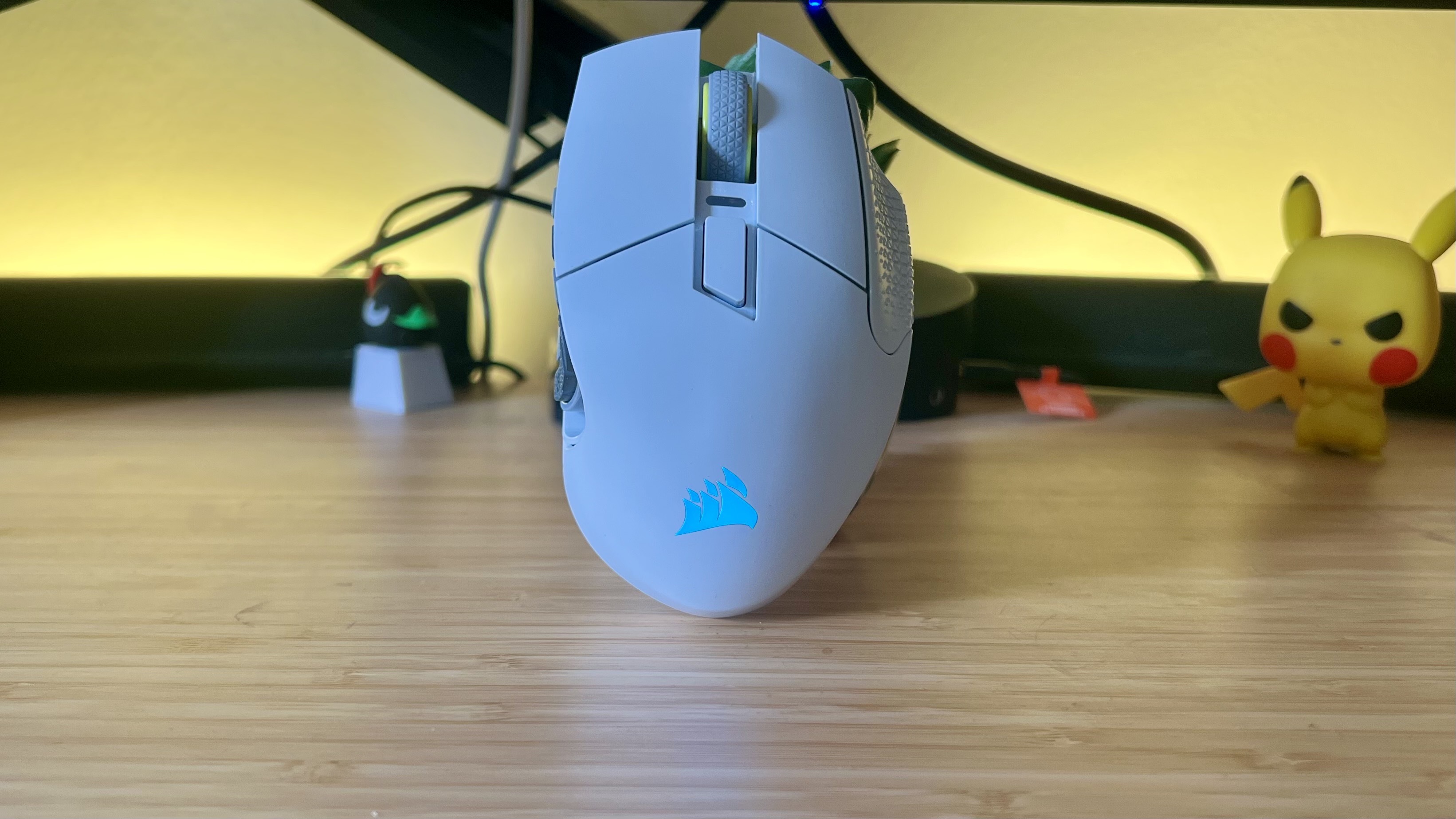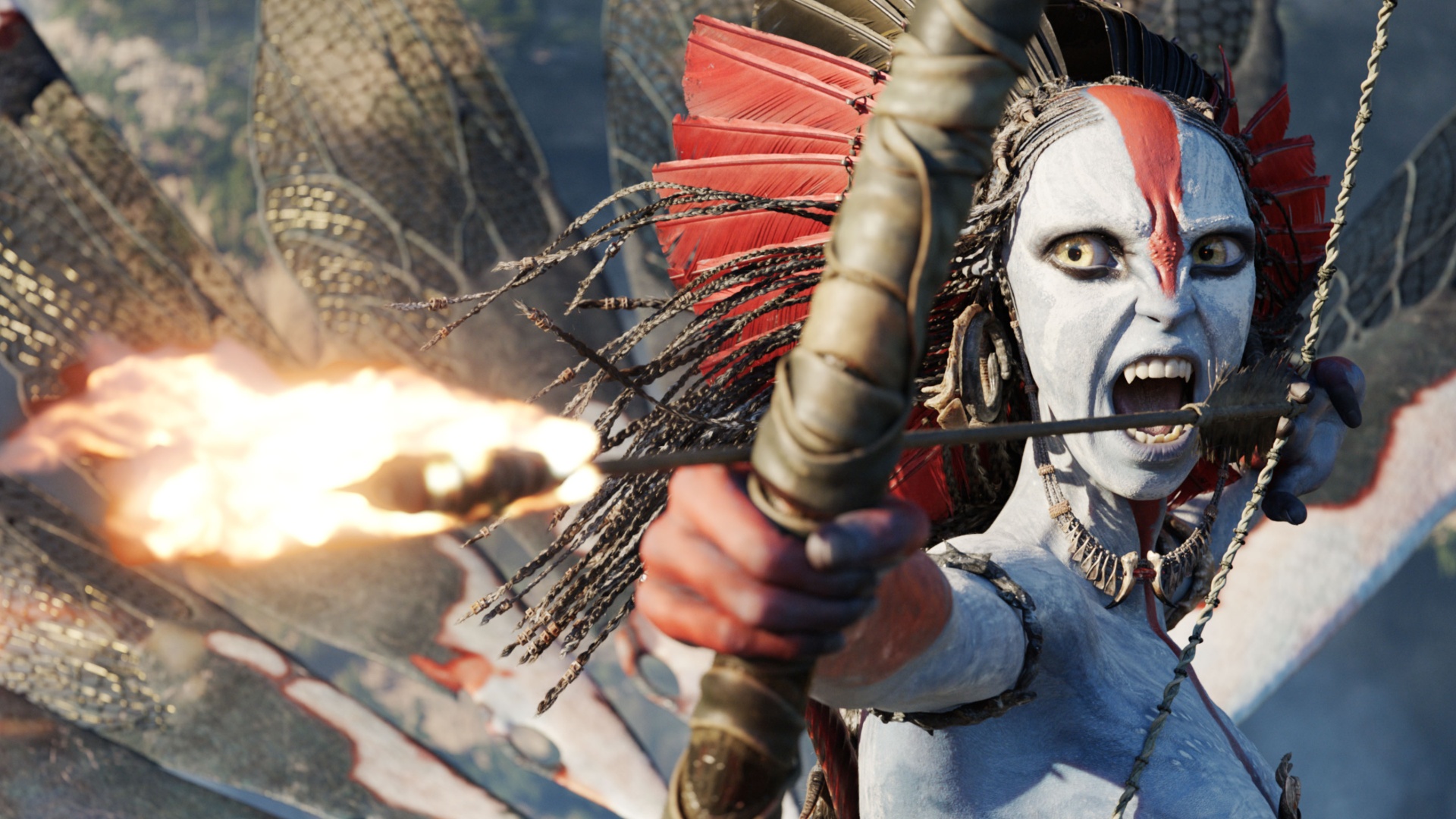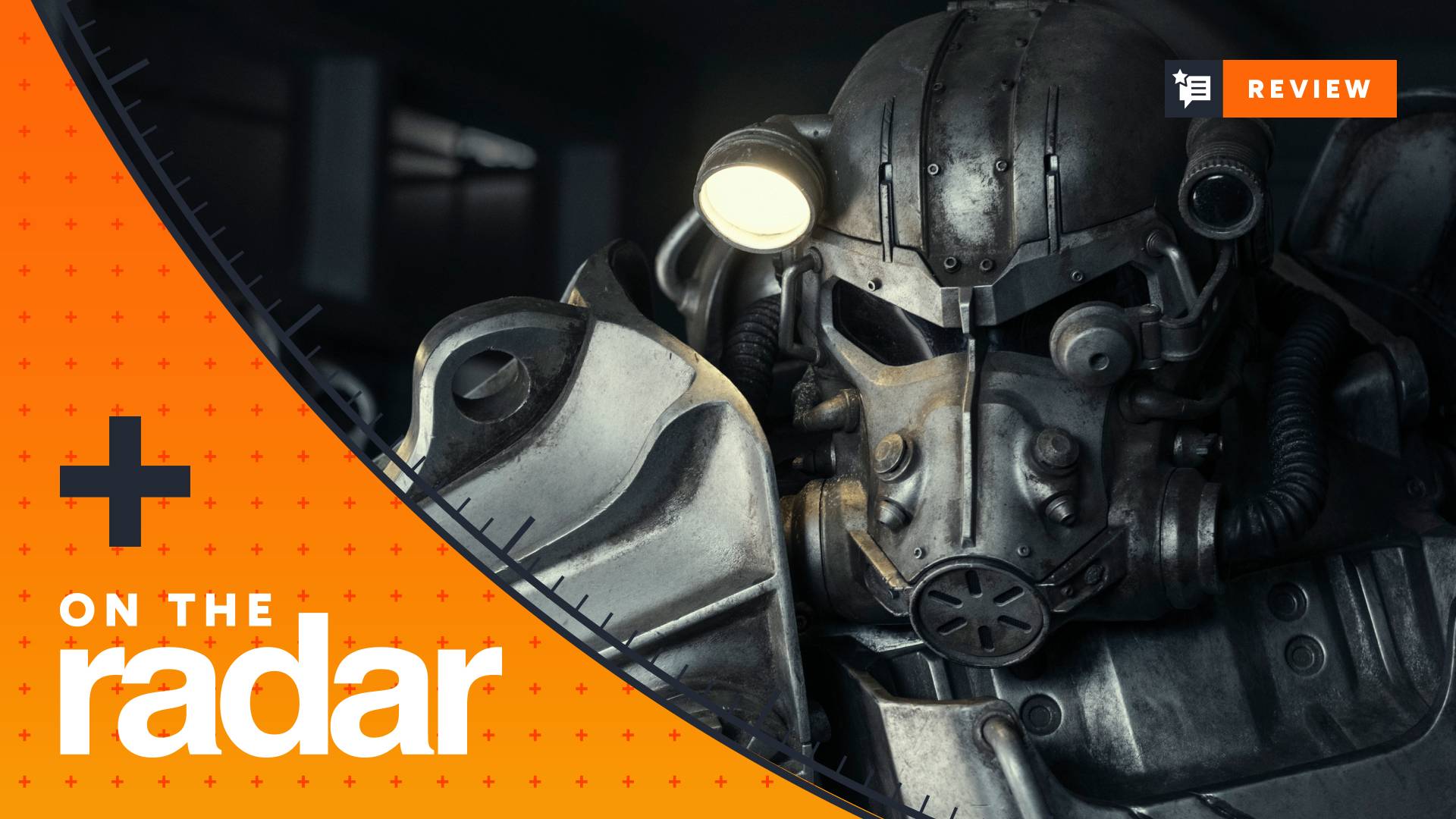GamesRadar+ Verdict
The Corsair Scimitar Elite Wireless SE feels made for streamers, but it's going to satisfy regular MMO players just as well. With a relatively low price, excellent battery upgrades and particularly easy-to-control side-buttons, this is a fantastic refresh of a much-loved line.
Pros
- +
Well-tensioned side buttons
- +
Crisp main clicks
- +
Reliable tracking
- +
Comfortable shape
- +
Unique Stream Deck functionality
Cons
- -
Can drag due to higher weight and smaller feet
- -
DPI button can get stuck
Why you can trust GamesRadar+
The Corsair Scimitar was a legend in its day, but with no new releases for a few years it's faded into the background more recently. Now it's back, with the Scimitar Elite Wireless SE - a traditional 12-button MMO mouse that looks to take the crown back from the brand's own Darkstar Wireless.
At $139.99, the Corsair Scimitar Elite Wireless SE is actually cheaper than a lot of the best gaming mouse models specifically designed for MMO play. Not only that, but it achieves this lower price point while bumping your sensor specs, improving battery life, and offering its own unique Stream Deck features at the same time. While it can be held back by its weight and software, those hunting down ultimate programmability aren't going to be disappointed.
Price | $139.99 |
Connection | 2.4GHz / Bluetooth / Wired |
Shape | Right-handed |
Buttons | 16 |
DPI | 33,000 |
IPS | 750 |
Switches | Optical |
Weight | 114g |
Battery | Up to 150 hours (2.4GHz, no RGB) |
Design
Corsair's classic Scimitar shape has survived to the new generation, with a rounded chassis that molds into a claw or palm grip and sits much wider than traditionally long and skinny FPS mice. Everything from the teardrop shape to the textured pinky rest has stayed the course, but nothing feels particularly cramped. It's still a fatter option than the SteelSeries Aerox 9, but it's far from the almost-circular feeling Razer Naga V2 Pro.
At its widest point, the Corsair Scimitar Elite Wireless SE measures in at 73.48 mm, while its max height reaches 42.17 mm. That makes it slightly smaller in both dimensions compared to the Naga (75.5mm wide and 43.5mm tall), though the contours of the body itself are more conducive to palm-tucking. The tapered lower half nestles neatly into my palm, reaching a surprisingly narrow point right at the bottom, whereas the Naga's flat edge can sometimes feel unwieldy.
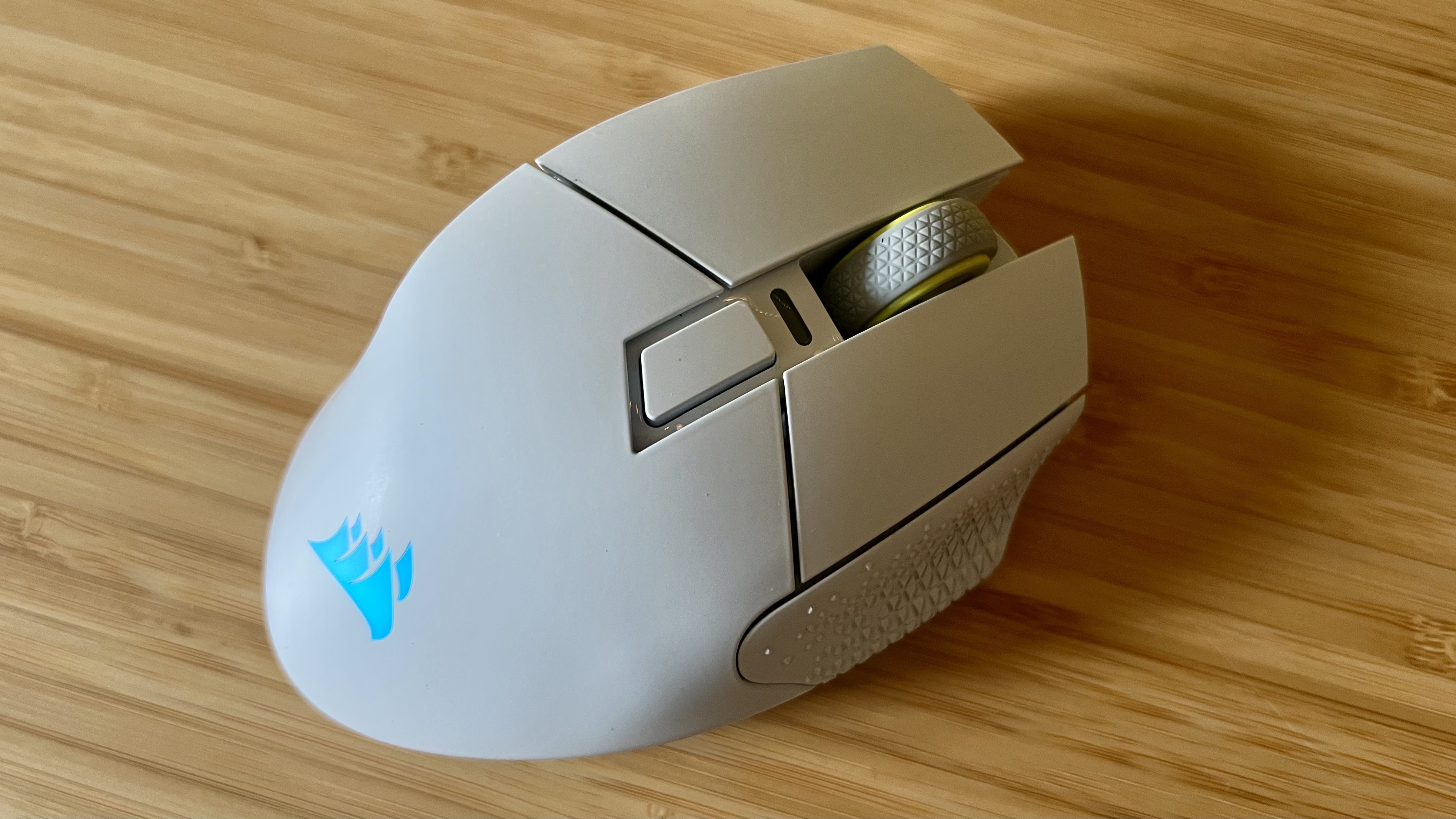
I received the white and gray colorway, though the Elite Wireless SE is also available in traditional black / yellow and a newer gunmetal style. The white version is a little less crisp than other white mice I've tested, with a dulled quality to the final color that feels more like a very light gray rather than a bold white. I'm looking at it next to the Razer Basilisk V3 Pro 35K, for example, and it's a little muted. The textured pinky rest picks up its fair share of dirt and grime, though, and being formed of raised plastic notches can be tricky to keep clean.
Still, everything feels well built. There's very little flex to the main chassis when pushing directly downwards, and only a slight creak to the side walls when squeezed with extra force.
This isn't the first time Corsair has set its 12-button side panel on an adjustable slider, but it's the first I've seen of it. There's a good range of movement here - those with particularly large or small hands will still struggle to maintain full control over all the buttons, though. With this range, it's more your grip type that's being catered to. Setting the button array towards the back of the mouse was is far more comfortable for a fingertip grip, while you'll need it bumped towards the front for a palm hold.
Weekly digests, tales from the communities you love, and more
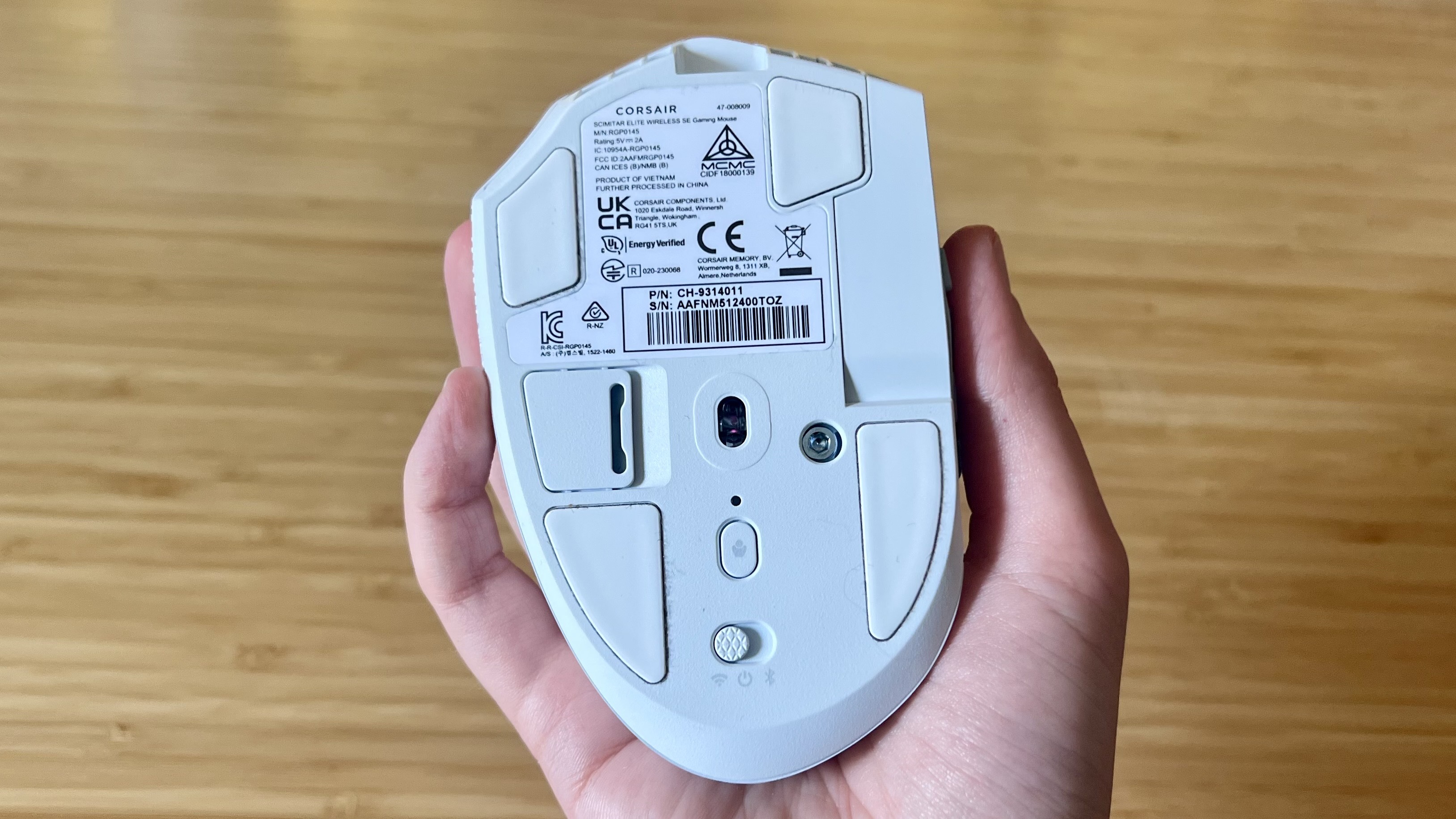
Actually making this adjustment is as easy as unscrewing a medium socket cap underneath, wiggling everything into position, and tightening it back up. An Allen Key is provided in the box.
The skates leave something to be desired. They may be 100% PTFE, but they're plonked down in smaller batches across all four corners and don't provide the smooth action of other devices. The Corsair Darkstar Wireless features larger foot panels that contribute to a more stable flow of movement. With the heavier weight (114g) of the Scimitar, things can drag a little too much to truly feel nippy.
This is a heavier mouse by today's standards, though it still has the Naga V2 Pro (134g) beat. It's actually one of the heaviest I've tested in the last few years, and I feel that extra heft most keenly in lift-off. It takes a real concerted effort to raise this device from its position on a pad, which takes it out of the realm of faster competitive titles. The best wireless gaming mice tend to stick under 100g these days, but that's without 12 side buttons. The SteelSeries Aerox 9 is able to get away with its 89g form factor is through a honeycomb cutout design, and that can present its own problems as well.
Controls
Still, if you're here for that 12-button array you likely prioritize extra functionality over low weight in your gameplay. I'm right there with you.
Razer might have introduced the idea of a full 12-button array, but Corsair's Scimitar design has been right up there ever since it debuted. This time there's an extra layer of programming available. Now that the brand owns Elgato, it's able to add a whole virtual Stream Deck to your mouse's functionality. That means the side panel can now control your stream, run productivity macros for a wide range of different programs, and act as a launcher.
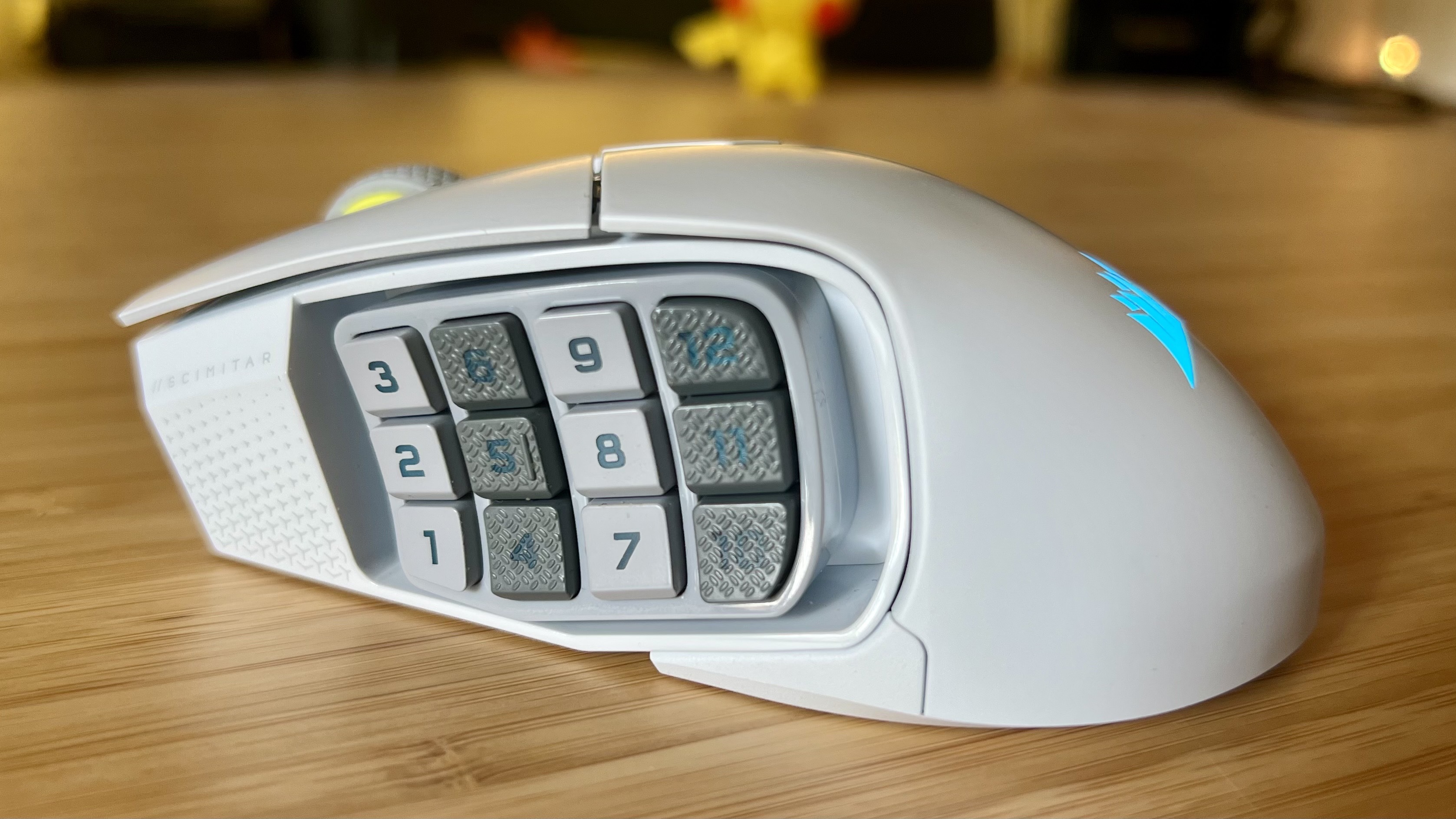
It takes a little learning without LED displays showing you what's what, but this quickly became one of my favorite features on the Corsair Scimitar Elite Wireless SE. I had different productivity presets with everything from specific Chrome tab launchers to individual image editing controls mapped out across the side of the mouse. If you're a power-user of a supported program (and thanks to the Stream Deck plugin database there's a lot of them) it's going to be a game-changer.
A lot of functions can already be matched with iCue's own macros, so this integration isn't going to be so revolutionary if you only want media controls and keyboard shortcuts. However, streamers who don't want to reach for a separate pad are going to have a field day here.

In total, there are 16 programmable buttons to play with; 12 on the side, two main clicks, a scroll click, and DPI shifter in the center. Everything sits within easy reach thanks to the adjustable panel design, and the side buttons feature a nicely textured surface that helps differentiate between each column. My only issue sits with that central DPI button, which feels tougher than most, actuates with a little reverb, and regularly became stuck during my testing.
Those actual side buttons are the best I've felt from an MMO mouse. They've got just enough weight to them to remain snappy and easily pressable, even at a slightly awkward thumb angle if reaching forwards or backwards, while resisting against accidental hits. The SteelSeries Aerox 9's clackers feel too light by comparison.
Software
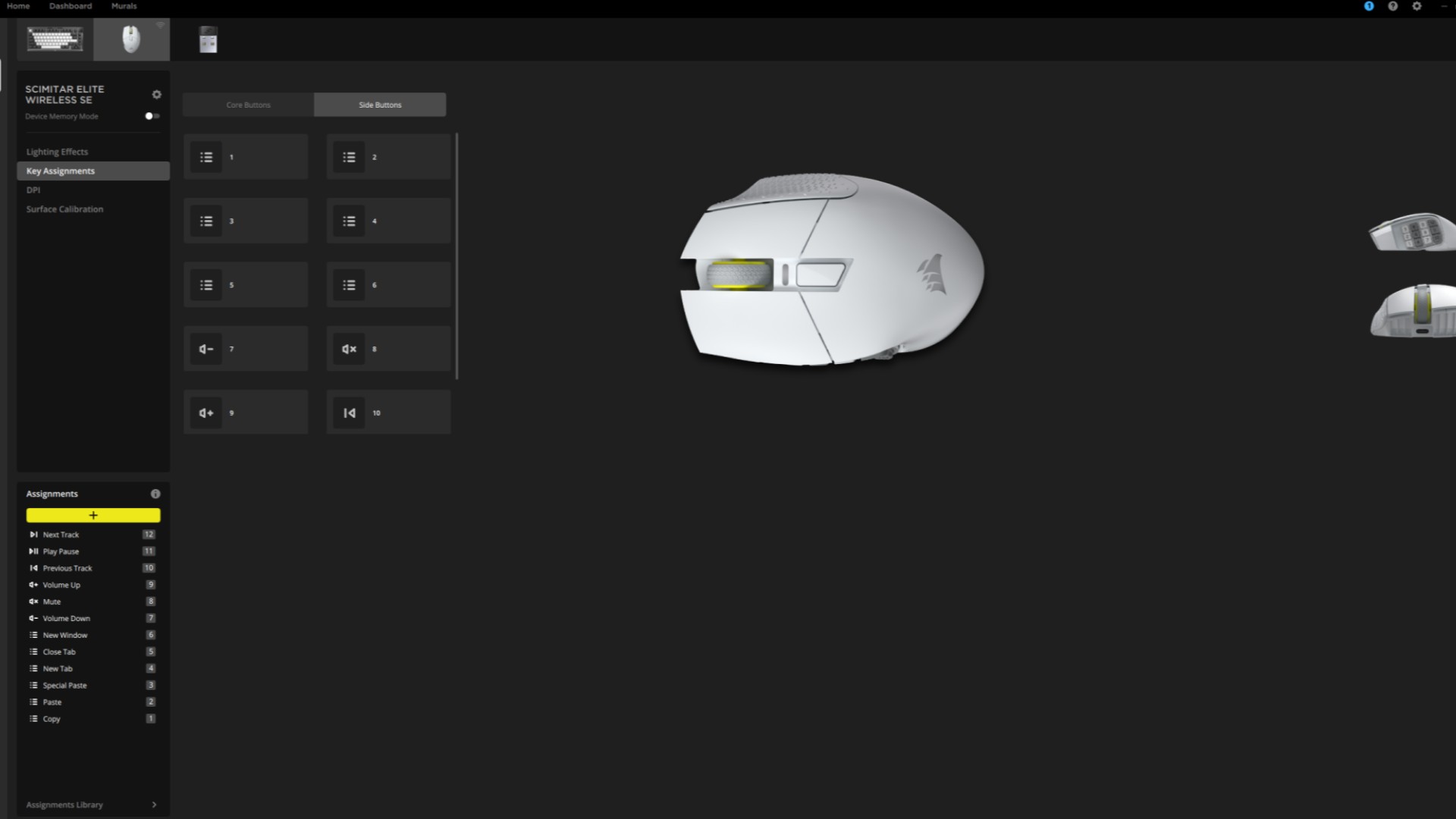
I don't think I've ever got on particularly well with iCue. It looks and feels outdated, with its small menus, unintuitive interface, and sometimes-confusing preset display. It's got everything you need, though, with customization options across RGB lighting, DPI settings, and individual keybindings. There's also a surface calibration feature included, which claims to optimize your tracking accordingly. Truthfully, I didn't particularly notice a difference in either gaming or productivity.
Slightly frustratingly, you'll need a whole second piece of software to load up your Virtual Stream Deck, and the two don't always play nicely with each other. Switching between onboard controls and Stream Deck controls is a little janky with two programs butting heads and getting everything working in the first place is a maze of menus, firmware updates, and permissions.
Additional sensor features like Angle Snapping, lift-off distance, and power saving modes are buried in a buried, pop-up Settings menu, and polling rates are controlled via the receiver's icon instead of the mouse's. It's all a bit scattered, and it doesn't feel particularly slick to use.
Connection
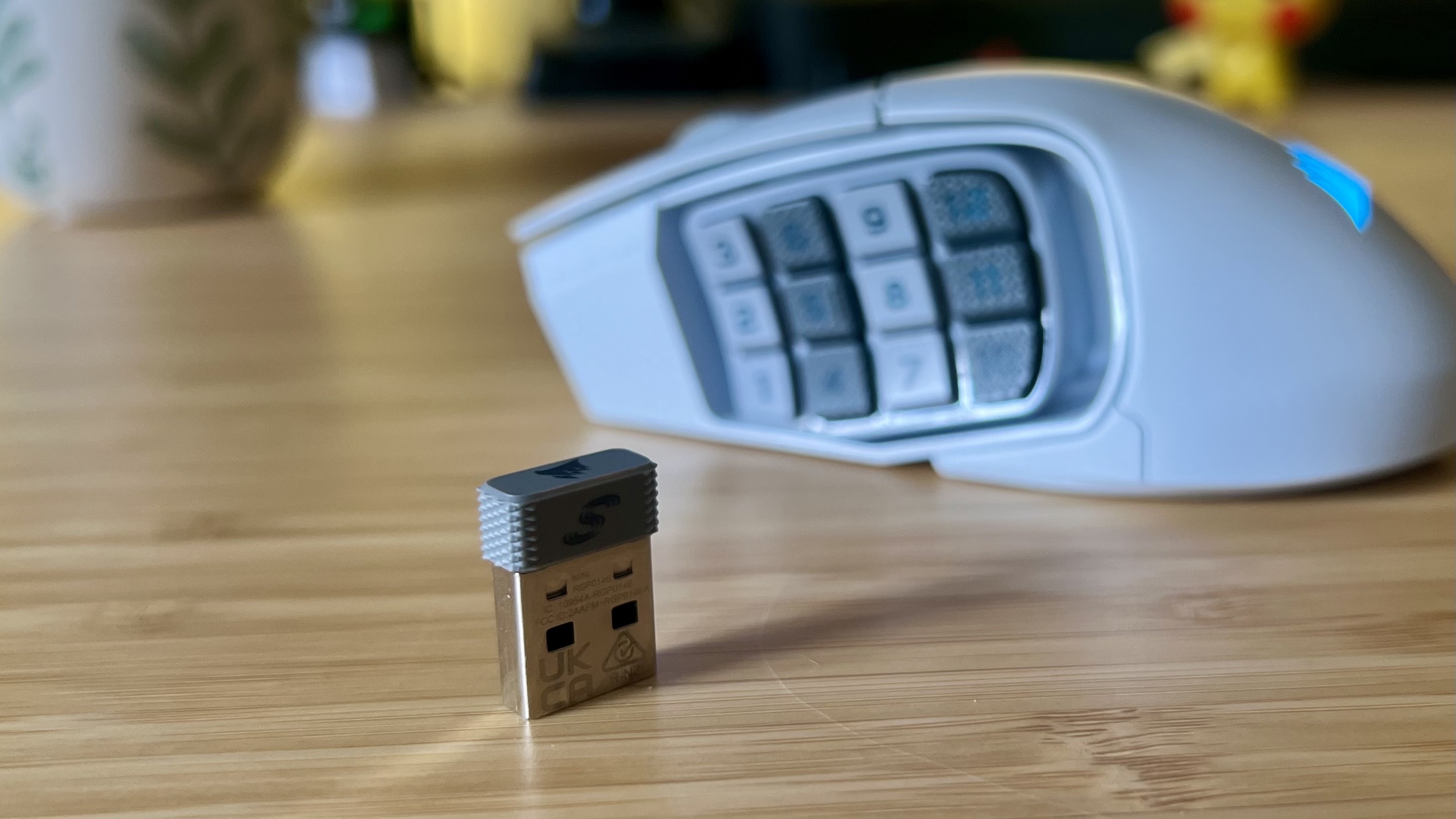
The Corsair Scimitar Elite Wireless SE can connect via the brand's Slipstream Wireless (2.4GHz), Bluetooth, or a USB-C cable. The cable supplied in the box feels solid, and I was able to plug in third party wires, though there is a cut-out around the port itself that could exclude larger connectors.
The mouse can poll at 1,000Hz, but the Slipstream receiver goes up to 2,000Hz. That left me with some confusion at the start of testing, but if you're only using the Scimitar this seems to be a redundant setting.
I never had any issues with tracking or latency when using the device in either 2.4GHz or Bluetooth mode, even with a high amount of interference running around them.
Battery
Corsair claims the new Scimitar can run for up to 150 hours in 2.4GHz mode and up to 500 hours in Bluetooth mode, both with RGB switched off. That's solid, battery was a key issue for the Darkstar Wireless with only 20 hours up for grabs.
That figure rings true from my testing. I'm on mouse and keyboard for an average of around 50 hours a week between work and gaming and I'm still on 62% battery after a week and a half's solid use (no RGB, 2.4GHz). That puts the Corsair Scimitar Wireless SE's battery above that of the 95-hour Logitech G Pro X Superlight 2 DEX and 80-hour SteelSeries Aerox 9, and tied with the Naga V2 Pro.
Sensor
A 33,000 DPI Corsair Marksman sensor sits underneath, boasting 750 IPS speeds and up to 50G acceleration. That's a good sensor spec sheet, shooting just over the top of the Naga V2 Pro's 30K DPI and extending well beyond the 18K DPI / 400 IPS eye inside the SteelSeries Aerox 9.
Of course, very few of us are playing right at the top of that DPI range - but it is good to know that the sensor's sensitivity is adjustable in increments of one, which makes for a particularly precise setup experience. Running at my usual 3,200 DPI everything feels smooth and accurate with a consistent tracking rate across both a wooden surface and a softer mouse pad.
Lift-off distance can be customized across three presets in iCue, ranging across low, medium, and high. There's no specific measurements listed, but I'd bet these settings translate to 0.7mm, 1mm, and 2mm. iCue also offers an angle snapping toggle.
Switches
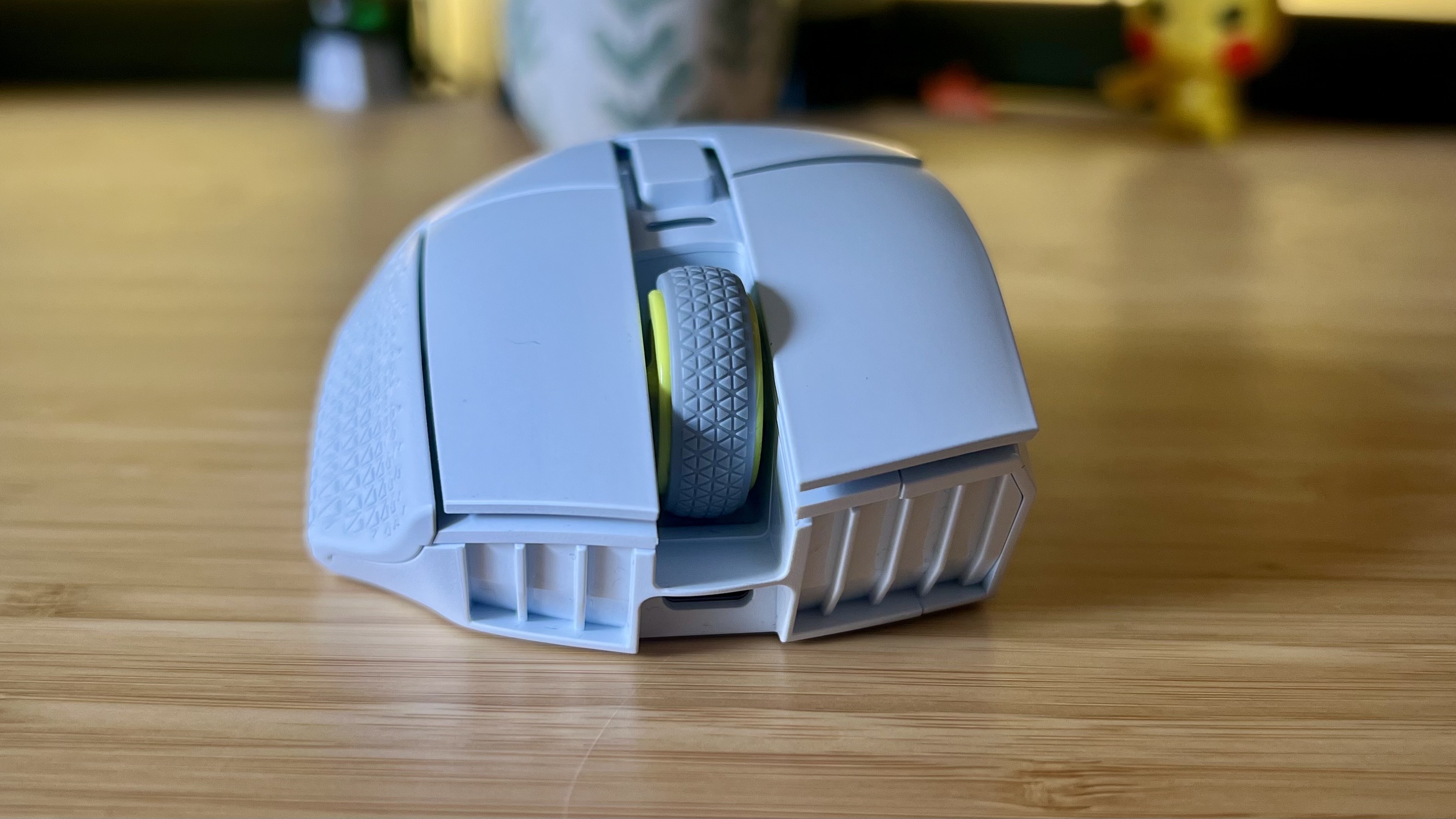
Optical main switches make for a light and speedy actuation in your larger clicks, and I found them to be uniform in feel and actuation speed across the entire panel of the button itself. They're not as deep and thoccy as other options, losing some of the tactile clunk of the best Logitech gaming mice and the best Razer mice, but feel nimble across repeat presses. They also feel nicely supported, with no wobble or reverberation and a tight feel overall.
Should you buy the Corsair Scimitar Elite Wireless SE?
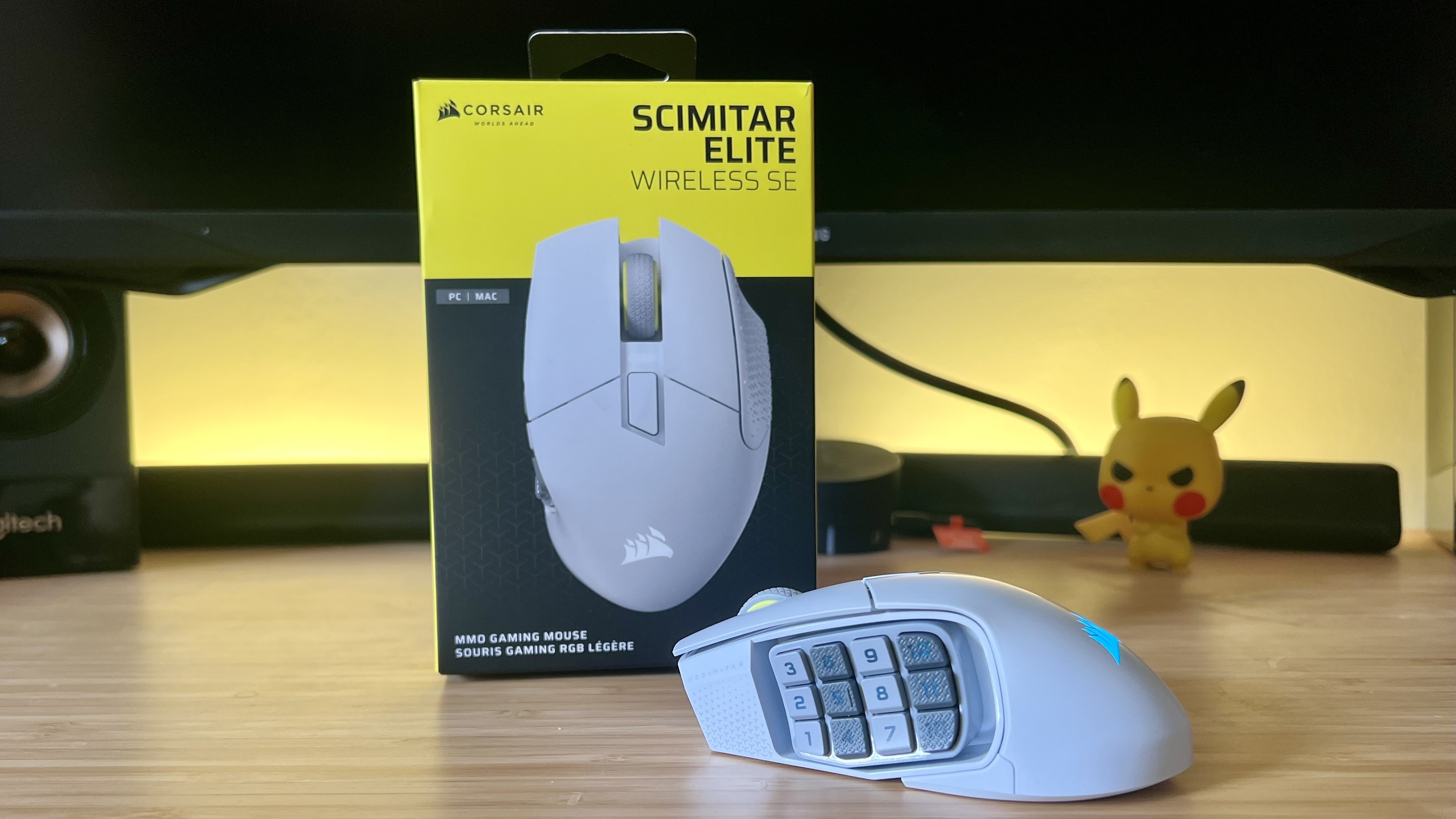
The Corsair Scimitar Elite Wireless SE is a fantastic MMO mouse, especially if you happen to stream your adventures. While that Stream Deck integration can take a while to get set up, it offers a particularly slick set of additional features for content creators and productivity power-users alike. Combine that with a comfortable side panel of buttons, each particularly well-balanced for responsiveness and accuracy, and you've got yourself a powerhouse.
The increased weight and often frustrating software may mean some should look to spring for the more expensive Razer Naga V2 Pro ($179.99), however with a vastly improved battery life and sensor compared to the $149.99 SteelSeries Aerox 9 and $169.99 Corsair Darkstar Wireless you're getting excellent value for money overall here.
The latter is currently my top pick for the best MMO gaming mouse on the market, and it doesn't even feature this 12-button array. I found the circular panel of side buttons to be far more accurate than the softer, more accident-prone clickers previously available on the market. The low price, improved button handling, and additional charge time of the Corsair Scimitar Elite Wireless SE propels it straight to the top of that list.
Comfort | 4/5 |
Speed | 3/5 |
Programmability | 5/5 |
Connectivity | 4/5 |
Battery life | 5/5 |
How I tested the Corsair Scimitar Elite Wireless SE
I used the Corsair Scimitar Elite Wireless SE on and off for around a month, testing other mice in between, but used the device as my sole pointer for just under two weeks before completing this review. I primarily used it across Apex Legends and Fallout 76, while also playing through Doom: The Dark Ages. For more information on how we test gaming mice, check out the full GamesRadar+ Hardware Policy.
If you're kitting out your setup further, check out the best gaming keyboards and best gaming headsets we've tested so far. Or take a look at the best PC controllers for a more traditional feel.

Managing Editor of Hardware at GamesRadar+, I originally landed in hardware at our sister site TechRadar before moving over to GamesRadar. In between, I've written for Tom’s Guide, Wireframe, The Indie Game Website and That Video Game Blog, covering everything from the PS5 launch to the Apple Pencil. Now, i'm focused on Nintendo Switch, gaming laptops (and the keyboards, headsets and mice that come with them), PS5, and trying to find the perfect projector.
You must confirm your public display name before commenting
Please logout and then login again, you will then be prompted to enter your display name.
